THE LANDSCAPING SOLUTIONS BLOG
Welcome to our Blog. Inspiration, updates and industry trends from the team at Landscaping Solutions.
SUSTAINABLE GARDEN DESIGN - THE FUTURE OF LANDSCAPING
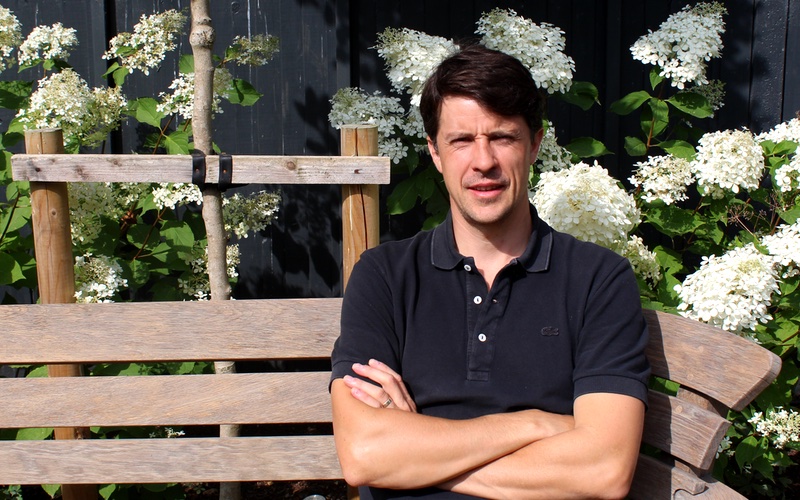
Ben West, Landscaping Solutions.
Garden designers and landscapers are in a unique position. We not only build gardens but bring an enormous pool of knowledge that influences the materials used, the plants chosen…and the wildlife that will visit them.
We’ll all take our own lessons from these lockdown weeks, but one of the precious things that they’ve given, rather than taken away from us, is time to think, to reassess and to create intent.
One of the most prevalent shared experiences of these weeks seems to be a greater appreciation of Nature, of its therapeutic value and how much we miss it when we cannot access it. Birdsong has become more noticeable, the air clearer. Butterflies seem more plentiful in the gorgeous weather.
Here in South West London, I’d venture that the leaves look a brighter green because of the lack of pollution.
Last year, the summit meeting at Futurescape concentrated on how the landscape industry might address climate change and I was on the podium as part of the discussion panel. When I looked around the meeting room, I saw impassioned and informed individuals seeking unity on the subject and itching for more progress within the industry.
It’s a matter that has been close to my heart for a long time. At Landscaping Solutions we began to increase the sustainability of the business some time ago. Seemingly small actions mount up to a much larger overall impact. But we believe there needs to be a more unified approach across the landscaping world.
Sustainability begins at ground level, before a spade is lifted. Putting it at the very beginning of a garden design project opens the opportunity for dialogue-rather than deciding on a material and us looking for a way to increase its sustainability through the supply chain or installation methods, it offers the chance to discuss materials and methods that the home-owner might not know to specify but which fulfil the brief.
Regenerative designs-those which add to the environment, rather than take away-are far more realistic, achievable and cost-effective for the average garden-owner than the slightly sterile designs that are so often to the fore in show gardens and which have such influence. We hope that trend-setters in the landscaping industry will push hard to move away from the unsustainable schemes that have been in vogue for so long.
This is an exciting time, full of hope. The Futurescape event made clear the hunger that members of the industry have for a different approach. There are designers around the country who put deep thought into how to make projects more sustainable, whether finding required stone onsite, using suppliers who propagate plants using peat-free compost, getting rid of waste products on Freecycle instead of sending them to the tip. There are many small steps that incrementally make a big difference, especially across an entire industry.
Here at Landscaping Solutions, we’re in the process of adding to our sustainability measures. Already, in sharing our knowledge of how to make gardens more attractive to wildlife, even with very small, easy-to-manage additions, we encourage garden-owners to widen the possibilities and create habitat that will sustain insect-life and the birds that feed on them.
For the future, we are looking to integrate an ecological assessment for each design and build. We’re examining ways to make the business zero-carbon or, at least, carbon neutral. We’re looking into the opportunities afforded by permaculture design. Can we create a suppliers’ carbon register, letting us align ourselves with suppliers with a good environmental approach? The possibilities are much wider than might immediately appear and many more ideas are under consideration.
What this means to home-owners is that they will know that their garden is not only contributing to the well-being of wildlife, giving their outdoor space an additional element to enjoy, but has made the least impact possible during its creation. It doesn’t have to mean a high-maintenance garden: minimising the necessity for power-driven maintenance tools is also a factor in the sustainable garden design.
For garden designers interested in working this way, Landscaping Solutions offers a sympathetic, enthusiastic partnership: solving problems, sharing knowledge, co-operating on plants and materials in a shared ethos, with no loss of quality or attention to detail in the build itself.
These lockdown weeks have given much food for thought to everyone, about our own lives, our working practices, the importance of personal contact, community and friends. In the context of gardens, they’ve shown us just how much we need a natural environment to recharge our batteries, to enjoy better health, to find serenity.
Now is the time to plan to act on this understanding. At Landscaping Solutions, we build award-winning gardens. We also want to build a better environment for us and our children.
We look forward to the exciting opportunities afforded by working with like-minded designers and suppliers. If you’d like to discuss the opportunities for your garden design, contact us at Landscaping Solutions now.
NATURE-FRIENDLY GARDEN DESIGN A SPECIALITY
Do you secretly long for a more Nature-friendly garden but fear the work involved? If you’re a garden designer, do you struggle to inject Nature-friendly elements into a brief because of clients fear it will result in an unwelcome workload?
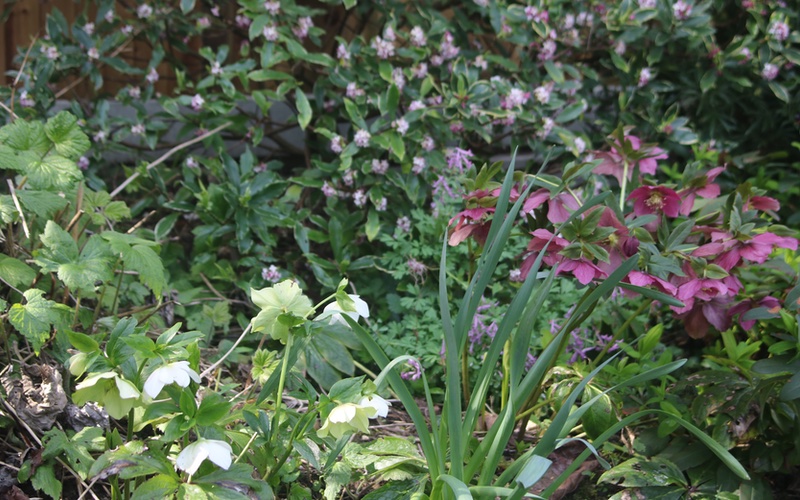
A low-maintenance corner of easy-care shrubs and perennials like the scented daphne (in background) and the hellebores in the foreground offer sustenance to insects early in the year. (Picture: Helen Gazeley)
Gardens are many things: a place to relax, to entertain, a play area for the kids, a haven, perhaps just somewhere for the cats to laze in the sun. Whatever it is, it certainly shouldn’t be a burden.
A garden is also where the natural world comes closest to our lives.
If we allow it to.
Garden-design briefs often veer towards pushing Nature away. Even as the merits of trees and plants in controlling pollution and producing cooling effects, the advantages of wildlife corridors across cities, and the physical and mental health benefits of looking out at a natural scene are increasingly understood and extolled, we lay more artificial grass, cut down trees, and even pave over entire gardens, generally in the interests of Low Maintenance.
Mea culpa!
The Outdoor Room
In part, it is the landscaping industry’s fault. We have spent the last two decades, since Groundforce took TV viewers by storm in the 1990s, describing the garden as an outdoor room, making it out to be an extension of our living space. And while we can certainly extend our day-to-day living into the garden, it is most certainly not a room.
What has been the effect of calling a garden an outdoor room? We suggest that it’s subtly altered expectations, and had a major impact on the look of gardens over the subsequent decades. If the garden is another room, it should look pretty much the same all year round and, if it’s a room, then all it needs is a quick dust, Hoover and tidy-up every so often, just like the lounge indoors.
In many ways this is ideal. Low maintenance is understandably one of the most frequent demands for a garden design, with mowing, weeding, leaf-blowing and pruning kept to an absolute minimum.
But what is missing?
Benefits of a Nature-friendly garden
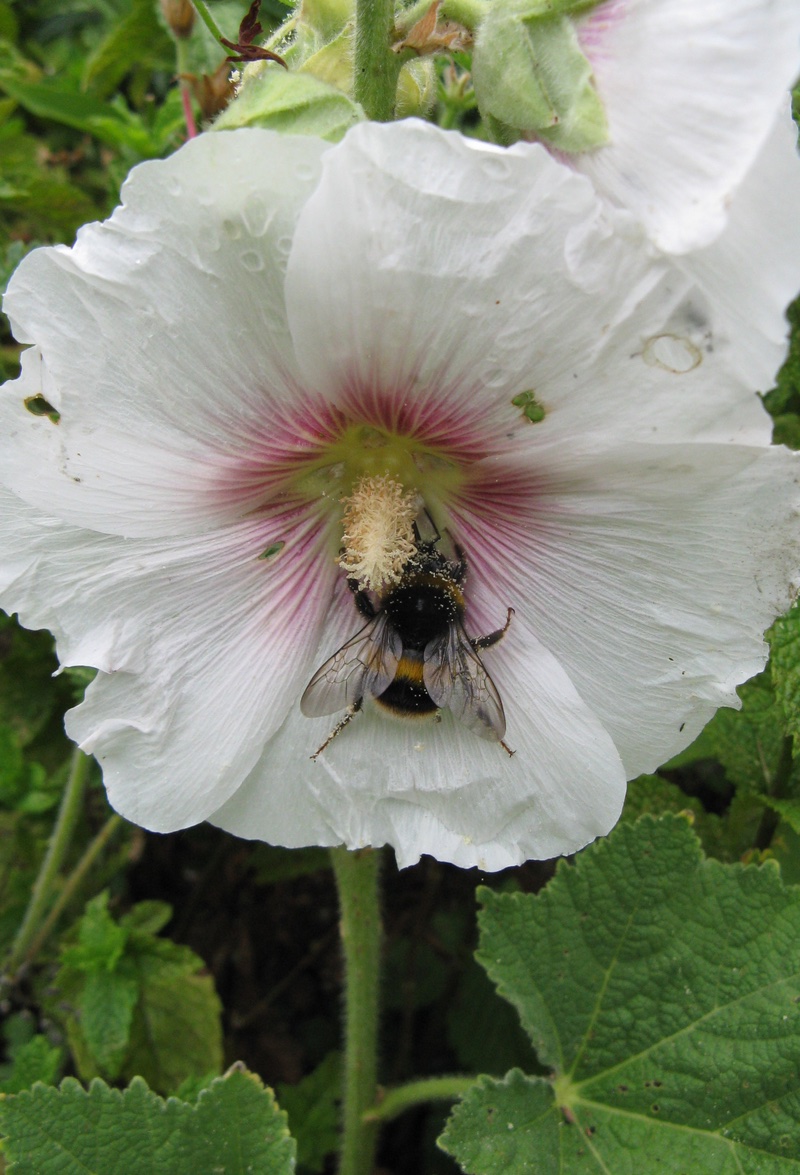
A single flower gives bees the chance to collect pollen where double flower sometimes don't. (Picture: Helen Gazeley)
A nature challenge run by The Wildlife Trusts in 2015 asked participants to do one “wild” activity every day for a month. Participants reported at intervals on how they felt. It turned out that even simple activities like feeding the birds and planting bee-friendly flowers made a difference, with an increase of 30% in participants reporting themselves in excellent health at the end of the challenge.
Other research has demonstrated how a view of nature reduces the need for pain-killers, aids healing, rests the mind and reduces negative emotions.
Children gain enormously from interaction with the natural world. In fact, research into human development portrays childhood as a time when we particularly want to explore it.
And none of the above is possible without the building blocks of a Nature-friendly garden that will attract the wildlife to give you the restorative and stimulating environment that will make a haven for you and a playground for your children.
The landscaping industry’s role?
At Landscaping Solutions we believe that we all have a responsibility towards Nature.
We feel privileged to be part of an industry which is uniquely placed as a bridge between the needs of our clients and the natural world. We can distance people from Nature, or we can create a manageable environment which harmonises with Nature.
If we look after it, it will repay us, with all the benefits listed above.
Client-friendly AND Nature-friendly
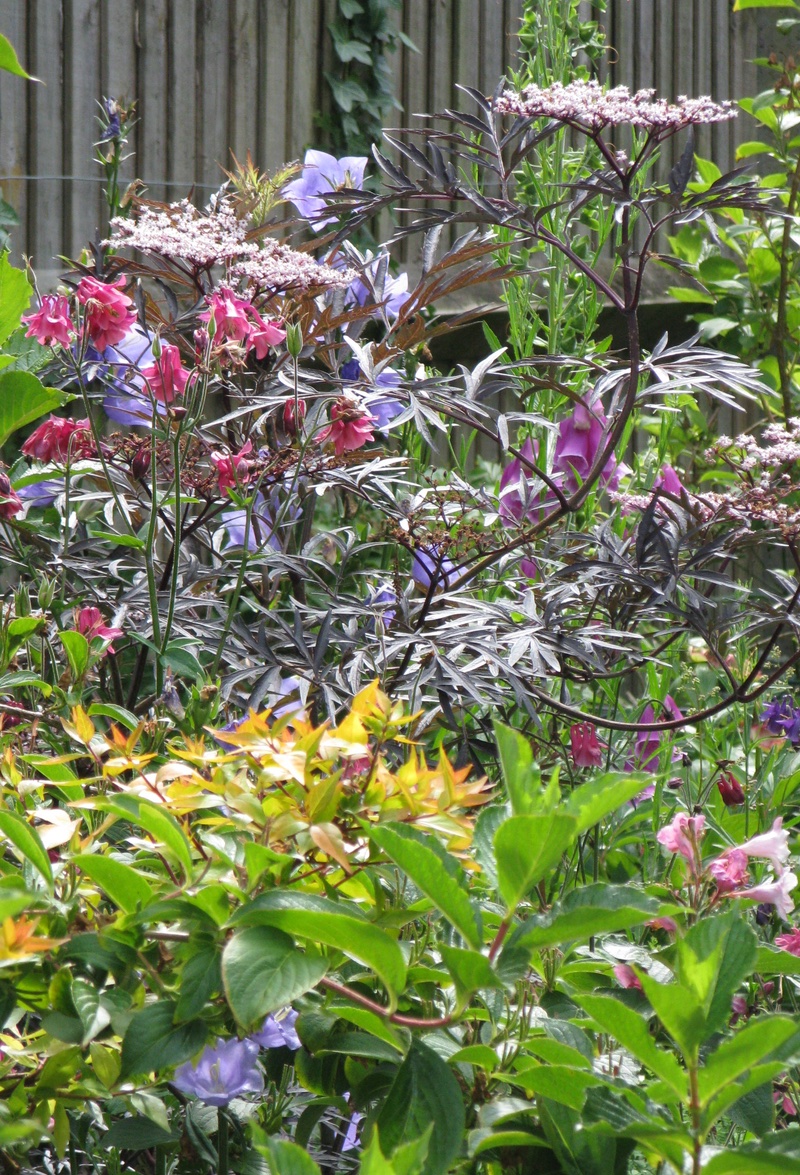
A mix of summer shrubs and self-seeders creates a nectar-rich corner. (Picture: Helen Gazeley)
What does this mean for your garden or, as a designer, your clients’ garden? At Landscaping Solutions, we’re not advocating creating a wilderness outside the back door. We have built award-winning gardens that major on high-quality hard landscaping, with very formal designs and minimalist planting. We’re not going to preach about what should and should be in your or your clients’ garden. However, we choose our materials and plants mindfully.
And this is where we can help. Most garden-design briefs allow plenty of room for nature-friendly elements creating regenerative garden designs that add too, rather than take away from, the environment. They may not be things that you immediately associate with a low-maintenance garden but, if properly installed, they require little attention while enhancing the design, bringing the pleasures of Nature closer to your window, and making a more sustainable design for local flora and fauna.
Here at Landscaping Solutions we have an excellent understanding of how to introduce tiny differences with a big impact, adding a Natural element and yet give you a living space that you can use as part of your daily life and not slave over.

Ivy makes an ideal, easy-to-trim fedge (mix of hedge and fence) and strikingly structural fruit which feeds thrushes in winter. (Picture: Helen Gazeley.)
From choice of productive shrubs, trees and nectar-rich flowering plants that will attract and feed wildlife, choice of grasses and wildflowers for the lawn and minimum grass-cutting regimes, to the installation of safe ponds and small areas of locally appropriate habitat, we have plenty of tools in our toolbox to create a design that will give you an interesting, sustainable garden throughout the year.
We work sympathetically with designers who want to expand the Nature-friendly extent of designs. We can also provide a garden design service. Alternatively, if you would like to make some changes, however small, to your existing garden with a view to supporting wildlife and are wondering what you could reasonably do, we’re happy to advise.
For more information or an informal chat about options, contact Ben West.
STOP PRESS:
At Futurescape on 19th November, Landscaping Solutions’ Ben West will be taking part in the Summit at the end of the day.
A leading industry event, taking place at Sandown Park Racecourse, Surrey, Futurescape brings designers, landscapers and contractors together from all over the UK, creating a stimulating platform for industry debate. Ben will be asking exactly what are our responsibilities as an industry in creating outdoor spaces, and how can we reasonably fulfil them?
LANDSCAPING SOLUTIONS BUILDS WOW FACTOR INTO AWARD-WINNING GARDEN DESIGN
Indoor/outdoor living. Once something of a novel idea in the UK, it’s now a staple ingredient of garden design and, as garden landscapers, we get huge satisfaction in a clients’ delight at their new connection with the outdoors when a design is complete.
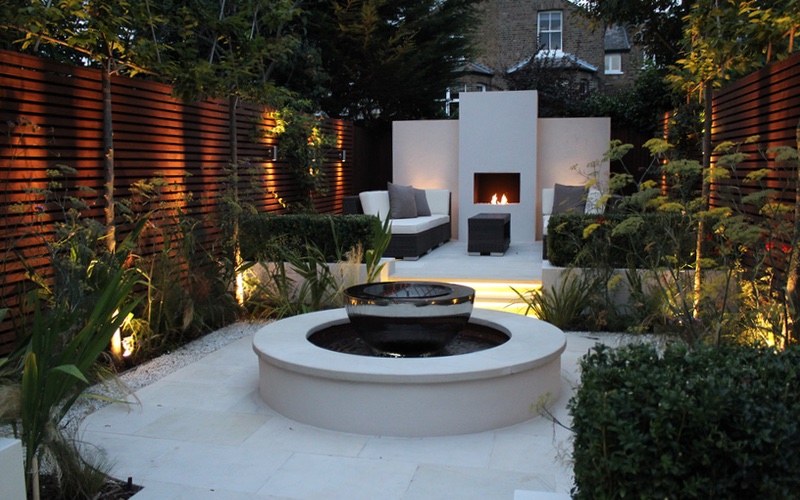
Crisp lines characterise this stunning garden design in South West London.
Often bi-fold doors opening onto decking is all that a client asks for, especially in the small gardens you find in urban Surrey and London. So much more can be done, however, and we were thrilled to be involved in this stunning BALI-award winning build in South London, a garden that offers multiple opportunities to enjoy the outdoors throughout the year, and which provides real-life inspiration.
The garden design brief
The brief was very clear - a space for entertaining and which would provide entertainment. A strong geometrical design was important, with all-the-year-round interest provided by structural, symmetrical planting. “With our large glass doors at the back of the house, we felt that it needed to feel like a natural open continuation of the kitchen/dining room, with similar smooth floor tiles and at the same level,” said the client.
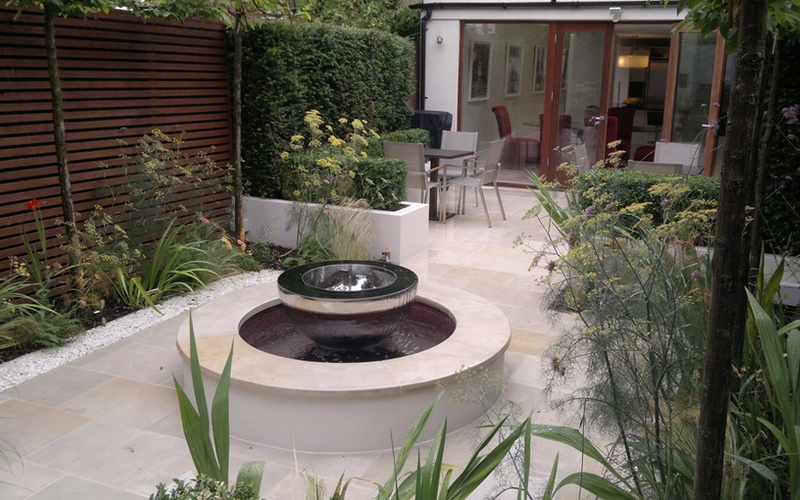
The client wanted a garden that they could walk straight out into on the same level in bare feet.
They wanted a contemporary space suitable for relaxation and reflection and which naturally felt part of their living area. “I wanted a garden that I could walk in and out from the kitchen without shoes, on a flat, clean and smooth surface.”
And - for a busy family - low maintenance was a priority. “Our expectation for our new garden,” said the client, “was that it would not only have a design wow factor, during the day, at night, and through the seasons, but it would also be comfortable to live in with children.”
Garden designer Simon Thomas excelled at fulfilling the brief. Then it was Landscaping Solutions’ turn to get stuck in.
Starting the Landscaping
As is so common with garden landscaping projects in London, the only entrance was through the front door and all waste had to be removed through the house.
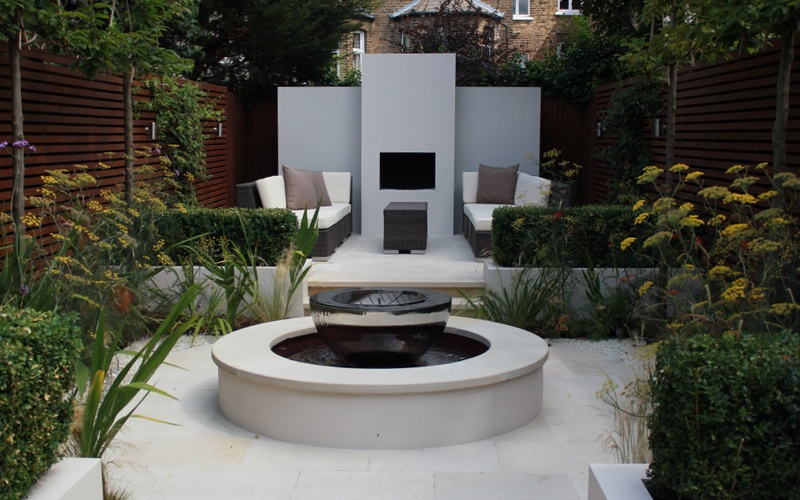
Planting includes pleached Carpinus betulus to add height and structure, with Lonicera japonica ‘Halliana’ scrambling over the screen fencing, while Foeniculum vulgare ‘Giant Bronze’, Verbena bonariensis and Crocosmia ‘Lucifer’ add airy planting to the architectural Buxus sempervivens and Taxus baccata hedging.
“This involved the removal and manual handling of at least ten tonnes of existing soils and turf, stone paving and a timber deck,” says Ben West, owner of Landscaping Solutions. “As London gardeners, one of our daily tasks revolves around making sure that the client assumes that nobody has been in the house.”
This means that, every bit a part of our job as is excellent workmanship, is ensuring that our exit path is clean and tidy at the end of the day, ready for the clients to come home.
The landscaping teams at Landscaping Solutions really enjoy their work. As we explained in a recent post, teamwork is integral to the way we operate, so once Ben had visited the site and met the clients, he presented the concept to staff members for planning and construction feedback. Involving the guys who will be working on a project early on adds an edge to the result. “By the time we came to start work,” says Ben, “the construction team were really keen to get in and express themselves on the features and the detailing.”
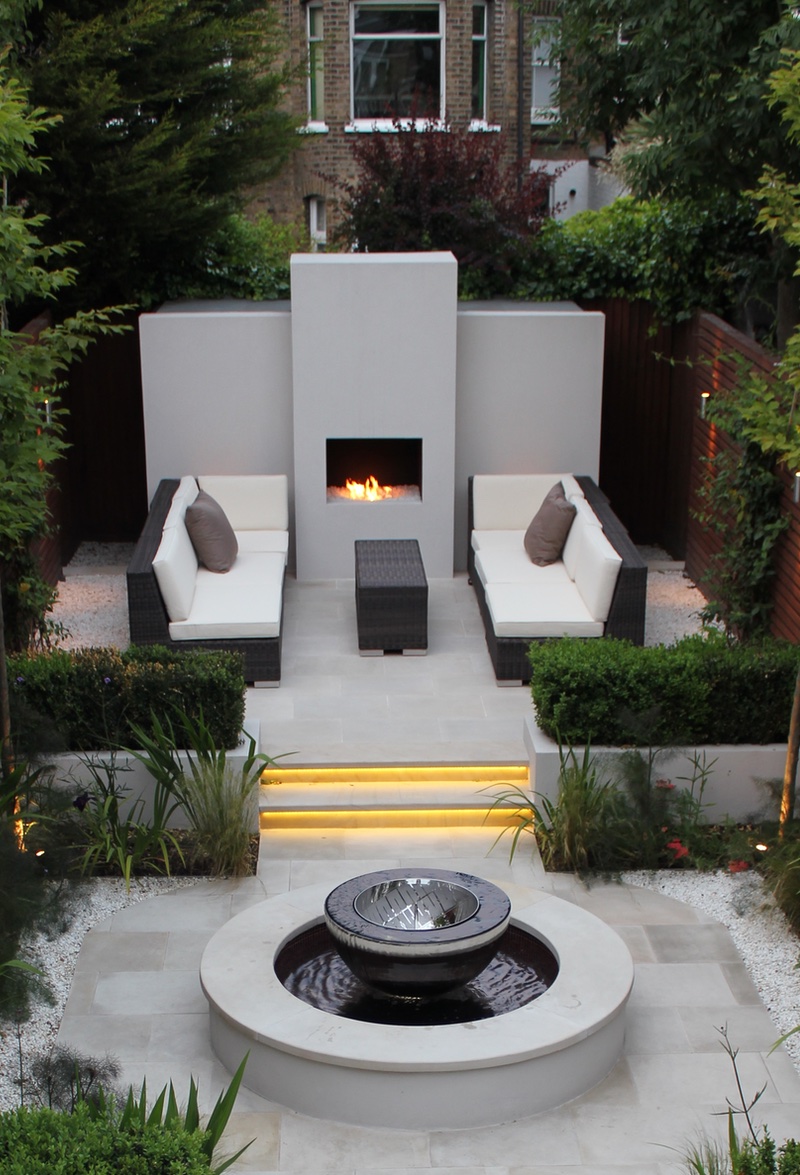
Boundary lines were tweaked to accommodate neighbours’ concerns.
London gardens don’t just have problems with access. Inevitably work impinges on near neighbours who voice their concerns, and it was no different here when the boundary lines went up as the first stage of the build.
Looking after relations with the people who will have to live with your new garden is another intrinsic, and very important, part of the job. “Good communication is essential when these situations arise, along with the ability to be flexible and think on one’s feet,” explains Ben.
We tweaked heights and levels on the boundary screens, and peace was restored.
Installing the pond and water feature
A water chalice designed by David Harber was a key feature, contrasting architecturally with the rectilinear fireplace at the end of the garden. We built a circular pool of rendered blockwork, coated inside with fibreglass and finished with mosaic tiles and bullnosed coping to pick up the step treads to the upper terrace, an addition made during the build.
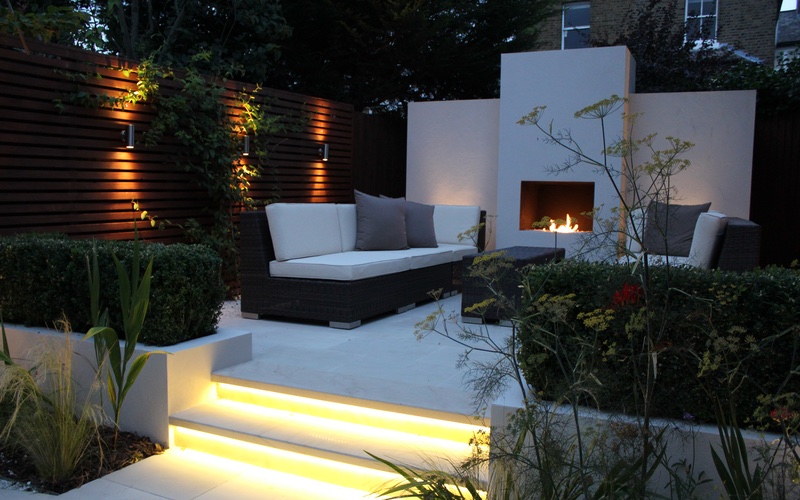
During the work it was decided to raise the fireplace above the rest of the garden, so a terrace was created with step leading up from the pool area. Behind the fireplace is a bespoke partitioned storage unit for bicycles, tools, toys and the gas bottle feed for the fire.
It was important to ensure the water from the pond didn’t overflow. Even though the Mint Sawn Sandstone paving was sealed, it could still stain from prolonged contact with water from the pool. We devised the remedy by installing a hidden submersible pump that could be linked to the main storm water system via sub-surface pipework and operated by remote control either from inside or away from the home. We also installed drip irrigation to all the flower beds.
Garden lighting
Remember the brief? That the garden would have a wow factor at night too? Stainless steel light fittings illuminate the screen fencing, LED light are recessed into the paving and raised beds, with strip lights illuminating the step treads and spotlights offering dramatic uplighting to the architectural planting in the beds. Again, they are remote-controlled. With the flames flickering in the fireplace, the wow factor is unmissable.
Award-winning result
At the 2011 BALI National Landscape Awards the judges commented on the “exceptionally good detailing” and awarded us Principal award in the £20,000 - £50,000 category.
Most of all, though, the satisfaction of the clients in having their dream realised was the highest reward. “On a personal level it was a great feeling to stand in the middle of the action,” says Ben, “working closely with the designer, the clients and our hard-working staff, and watch everything come together.”
For more information on how Landscaping Solutions can transform your garden, contact Ben on 0208 241 2402 or email info@landscapingsolutionsltd.co.uk.
GARDEN DESIGNER PAMELA JOHNSON
Here at Landscaping Solutions, we’ve got to know some of the garden designers we work with pretty well.
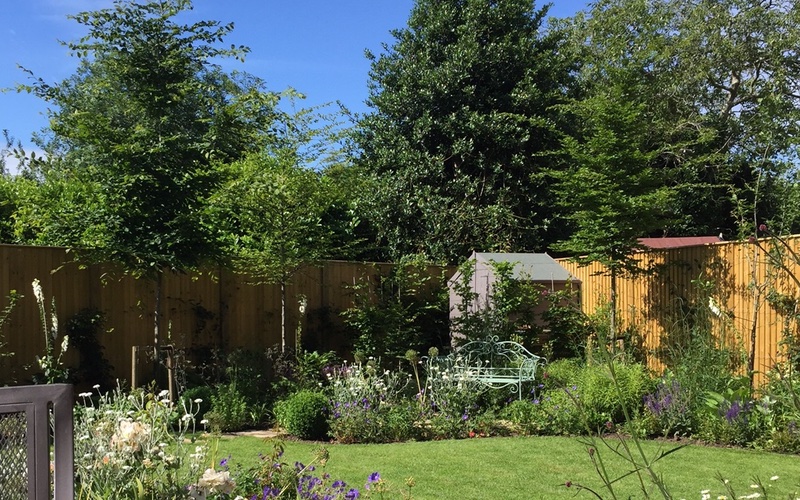
A garden in Hampton, Surrey, designed by Pam Johnson. She describes her designs as having become increasingly “planty” over the years.
One of the great pleasures of working with the same person on a variety of projects over the years is becoming familiar with another’s working practices so you virtually start from where you left off when the next garden design brings an opportunity to team up again.
“It’s the team you end up working with that’s critical,” says Pamela Johnson. Pam’s had twenty-five years’ experience in the business, training at the College of Garden Design when it wasn’t so much a growing profession, as she says, but a very small growing hobby. Things have certainly changed in a quarter of a century.
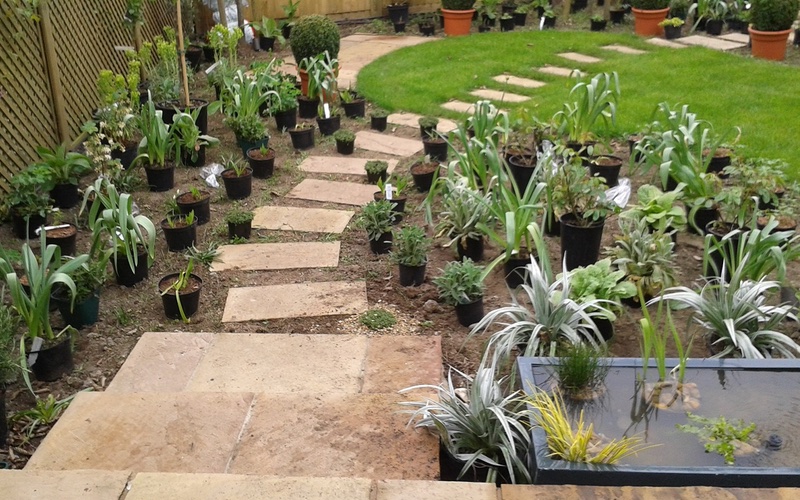
For Pam, there’s no substitute for good ground preparation. “If it’s not done properly, it’s hard to get a garden working when it all starts growing.”
Since she started, Pam has designed many gardens in and around London, but has now moved to Dorset. “I had enough of tiny London gardens and the logistics,” she says; if you’ve any experience of the problems of parking, access and spoil removal in Central London, you can probably sympathise.
While she was here, though, the result was some truly gorgeous gardens, of which we’ve been lucky enough to build a large number. Building relationships with designers is equally precious to us. “Ben’s very good with clients and good at running a team, which is critical,” says Pam, “but the next person who’s very important is the foreman.”
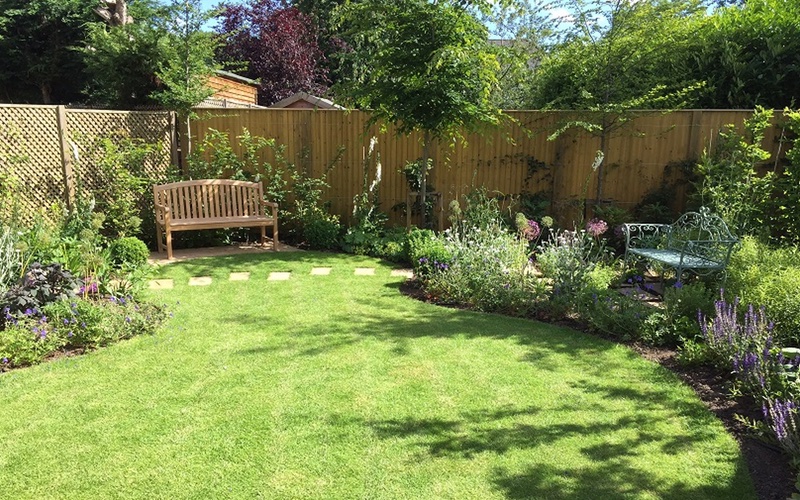
Another view of Pam Johnson’s design for a garden in Hampton, Surrey.
The foreman is the one who heads up the team on site, keeps things running smoothly, liaises with the client and keeps the designer informed on a day-to-day basis.
“As a designer,” adds Pam, “that’s the person you work with most.” Here at Landscaping Solutions we have three permanent teams and the foreman of each stays with a project from start to finish. “That’s critical, too,” adds Pam. “If a foreman has a good sense of design themselves, and an understanding of your design, is good with the client and understands your relationship with the client, then it’s good combination. If you’ve not got any of that, then it’s a nightmare. Tom, whom I worked with, is delightful, very talented.”
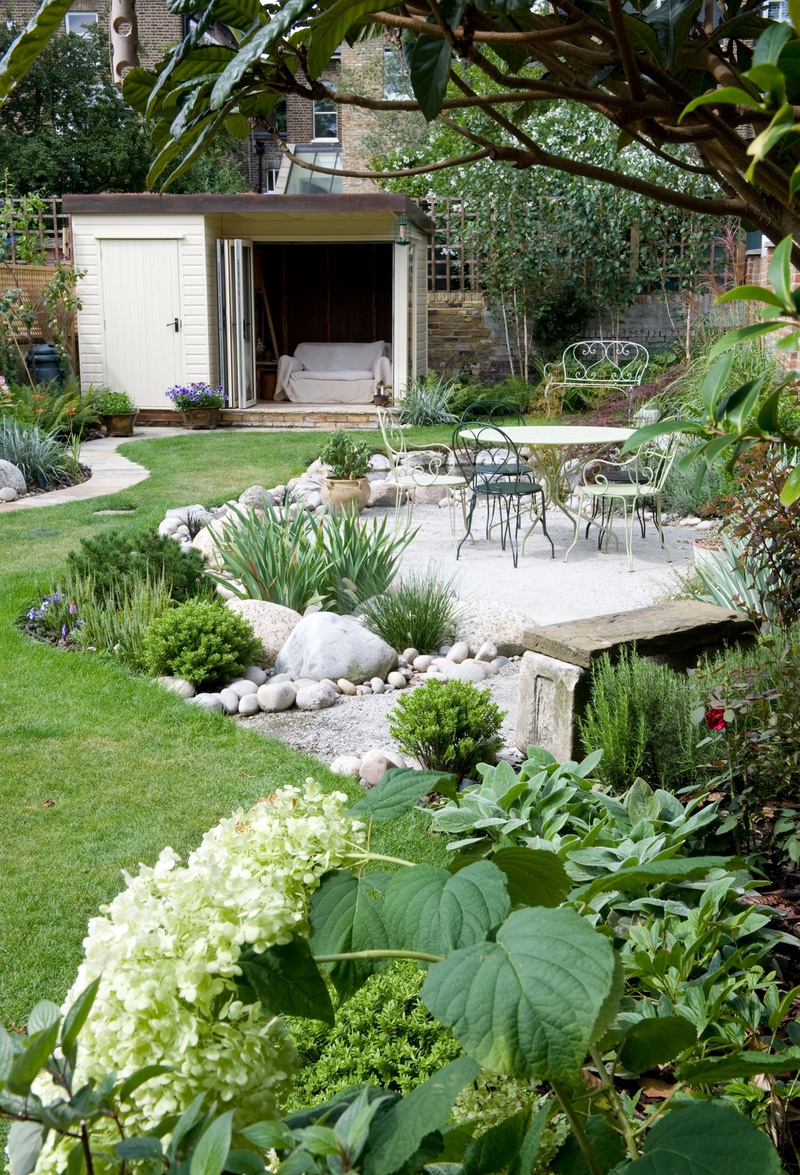
A beautifully balanced design which won a BALI award for a Surrey garden.
Pam approaches a garden very much from the point of view of the client. “I interpret within their means, manage their expectations. You don’t want something inappropriate to the circumstances. If I was to design something that I wanted, it wouldn’t fit the brief.” At the forefront is always the understanding that, as she says, “It’s not my garden, it’s the client’s garden. And it’s important for the landscaper to respect that too.”
There’s quite a skill to marrying up expectations with circumstance to create a happy solution. Some clients came to Pam because they loved the look of her own garden. “Aspirations can be tricky,” she says. “Unless you were a really good gardener, you wouldn’t be able to achieve that.”
Now in Dorset, Pam is taking a break from designing and, instead, is concentrating on working on the blank canvas of her new garden, currently mostly gravel. “It needs proper structure,” she explains, and she plans to do things gradually, seeing how they develop. “I’m doing it very slowly, rather than all at once. ‘Slow gardening’,” she laughs.
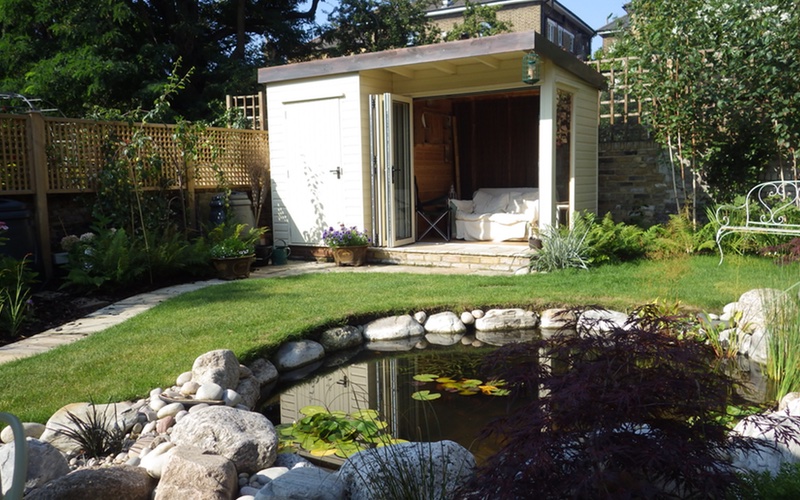
Pam used a sinuous path to echo the border of the pond in this BALI award-winning Surrey garden.
Starting when garden design was so young an occupation, Pam spent many years as a member of the Society of Garden Designers, which has presided over an improvement in working practices within the profession. “The SGD has set out quite rigid guidelines about how to conduct business, making sure everything’s done properly and professionally.”
This has turned out to be to everyone’s advantage, from the client, who knows that sensible quotations have been obtained, to the landscaper, who gets as full a brief as possible from the start. “The guidelines inform the way you deal with contractors,” explains Pam, “so you get comparable quotes for a specification. If all contractors quote for slightly different things, that means nothing.” As a client, it’s vital that your designer understands how to specify and get quotes. “There’s always an anomaly,” adds Pam, “but that’s the designer’s problem to work out.”
As anyone who’s had a garden designed and built knows, “something unseen”, as Pam puts it, is likely to crop up. If a problem occurs, it’s usually the site conditions at the centre of it. “The weather,” explains Pam, “or something buried, or a neighbour who complains.
“A landscaper can be instrumental in working something out,” she adds. “You need someone with good people skills. Ben will have a talk with a difficult neighbour and then say, ‘We had a problem, but we’ve sorted it.’ It’s great when someone does that.”
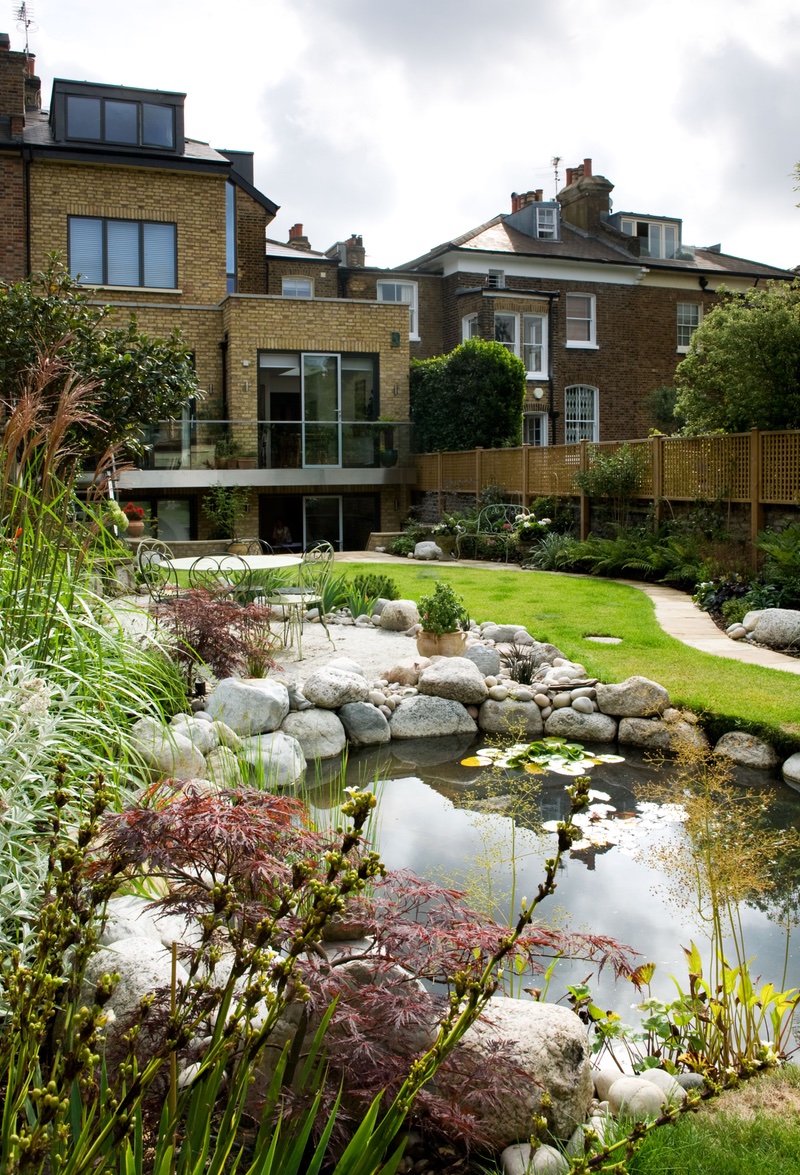
It’s important that a garden matches the needs of its owner.
Not only that, but we understand that the project we’re working on won’t be the only iron you, as a designer, have in the fire. “If you want him to, Ben’s very good at stepping in and dealing with stuff that would have been the designer’s job if, for whatever reason, the designer can’t do it,” adds Pam.
The better a designer and landscaper get to know each other and the way they work best, the easier it is to liaise and anticipate any difficulties in a build. That’s why we believe in the importance of getting to know how the designers we work with like to do things and in building up a relationship. We’re proud also to have contributed to the success of a number of award-winning gardens in London and the South-East.
Pam will eventually open her new garden for the NGS, but it won’t be very soon. In the meantime, however, keep an eye out for a blog about her new garden and courses on gardening. We’ll give you a shout on our social media when they start.
“Designing gardens is a delight,” says Pam. We couldn’t agree more!
If you’d like a chat about how Landscaping Solutions can help you achieve the design you want, then give Ben West a ring on 0208 2412402 or email info@landscapingsolutions.co.uk